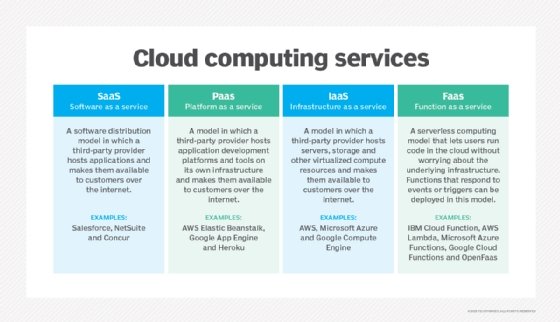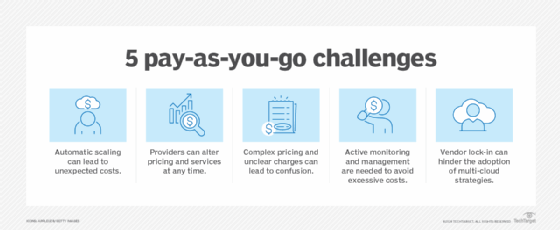
pay-as-you-go cloud computing (PAYG cloud computing)
What is pay-as-you-go (PAYG) cloud computing?
Pay-as-you-go cloud computing (PAYG cloud computing) is a payment method for cloud computing that charges based on usage. The practice is similar to that of utility bills, using only resources that are needed.
One major benefit of the pay-as-you-go model, which is a form of consumption-based pricing, is that there are no wasted resources. Users only pay for what they use rather than a certain amount of resources that may or may not be used. With traditional enterprise design, users architect data storage to handle the maximum workload. But with the public cloud, the pay-as-you-go method charges the organization only for what it stores, provisions or uses.
Pay-as-you-go platforms, such as Amazon Elastic Compute Cloud, provide services by letting users design compute resources and charge by what is used. Users select the CPU, memory, storage, operating system, security, networking capacity, and access controls as well as any additional software needed to run their environment.
There are three main categories of cloud computing services. Each uses a different form of the pay-as-you-go model:
- Software as a service. SaaS pricing can be based on features, storage capacity, or a per-user basis. Examples include Salesforce, NetSuite and Microsoft Dynamics.
- Platform as a service. PaaS resources can be priced per application, user, or gigabyte of memory consumed per hour. Microsoft offers a per-minute pricing model for its PaaS that stops the meter when an organization discontinues its use of a virtual machine (VM) but preserves the VM state and configuration. PaaS examples include Google, Oracle Cloud and Windows Azure.
- Infrastructure as a service. With IaaS, customers pay on a per-use basis, typically by the hour, week or month. Some cloud providers also charge based on the amount of VM space used. This model doesn't require users to deploy in-house hardware and software. IaaS vendors include IBM, Hewlett-Packard, Microsoft and Amazon Web Services (AWS).

Benefits of pay-as-you-go cloud computing
Traditional data center and colocation computing relies heavily on static resources. Engineers must plan and implement the computing, storage and other resources anticipated to support peak workload demand. This often led to costly overallocation with far more resources procured and deployed than were actually needed. PAYG cloud computing offers a variety of benefits that favor dynamic cloud environments:
- Ease of use. A cloud architect or engineer can adjust resources with a few clicks or even configure some resources to adjust automatically as workload demands change in real-time. This ease has played a major role in cloud adoption as both a supplement to local, or traditional, computing and cloud-first infrastructures.
- High scalability. Cloud providers can deliver enormous quantities of resources to drive almost any size workload or computing demand, such as big data analytics and other projects. Those resources can then be released when work is complete or demands change.
- Right-sizing resources. The challenge of traditional computing infrastructure led to enormous waste due to overprovisioning. PAYG cloud computing makes it easy to adjust resources to meet user demands, minimizing overprovisioning.
- Cost-efficient. The combination of ease, scalability and support for dynamic situations can potentially make PAYG cloud computing more cost-efficient than traditional data center computing, though savings aren't guaranteed.
For more on public cloud, read the following articles:
8 key characteristics of cloud computing
Public vs. private vs. hybrid cloud: Key differences defined
Choose the right on-premises-to-cloud migration method
Top 10 cloud computing careers of 2023 and how to get started
Drawbacks of pay-as-you-go cloud computing
In spite of its advantages, PAYG cloud computing also poses a variety of disadvantages that cloud architects and engineers should consider closely when planning a workload deployment in the public cloud:
- Planning challenges. A traditional data center computing model forces businesses to watch capacity closely and plan for increased capacity well in advance. With PAYG cloud computing, architects and engineers tend to be more reactive by adjusting cloud resources manually or configuring automatic changes in real-time. This puts the burden on businesses to implement and assess cloud utilization to ensure cloud usage maps with business plans and goals.
- Unpredictable costs. The dynamic and often automatic nature of cloud scalability means that businesses may not even be aware of the resource scaling taking place until the monthly bill arrives. The result is uneven and unpredictable costs. Unpredictable costs can complicate cloud workload budgeting at best. At worst, it can cause price crunches that might affect a business' ability to operate a cloud workload affordably. It's important to consider and implement scalability guardrails and alerts when planning a cloud deployment.
- Rules can change. Cloud providers can change prices, set utilization limits and make other changes to their resources and services over time. Any changes can affect an organization's ability to operate in a PAYG environment.

Types of PAYG cloud computing services
In general terms, all cloud computing is PAYG. Users may need to parse several possible payment models depending on the provider and the services. Understanding the potential variations in payment model may be important for reviewing and analyzing cloud computing costs over time.
- Subscription-based payment model. A subscription is typically the most familiar and traditional PAYG payment model. Access to a product or service is procured through a fixed, recurring cost such as per user per month. PaaS and SaaS offerings frequently use a subscription model such as cloud storage or Microsoft Office 365. Subscriptions are easy to understand, but they're often underutilized. For example, an Office 365 subscription may enable continuous access to the Office suite for a fixed cost, but no human will use that SaaS 24/7 year-round. If a typical employee uses their Office subscription an average of four hours per day, the rest of that subscription time is wasted.
- Pay-as-you-go payment model. This is the most common form of PAYG model where users pay only for the resources that are actually provisioned and operational. For example, if a cloud user provisions a VM instance, users will pay for that VM each month for the duration of that allocation. The user stops paying for that resource once it's relinquished. However, this model doesn't consider utilization -- it doesn't matter whether the business is actually running anything on those allocated resources.
- Pay-as-you-use payment model. This is a recent expression of PAYG where cloud users pay only for the resources that are actually utilized or performing actual work. Function as a service is a popular example of this model. Users pay for the function resources, such as servers and storage, only while the function is actually executing -- often to the closest second or fraction of a second. A popular variation of this model is pay-per-call, where users are charged a fee each time a service is invoked, such as API costs per call.
Payment models aren't mutually exclusive. A cloud provider may offer services that involve all three models. In addition, a cloud service may have multiple payment models, such as subscription and per-use fees. Cloud engineers must have a clear understanding of each resource and service cost structure when architecting a cloud infrastructure for business applications. Ongoing cost tracking and analysis are crucial to cost-effective PAYG usage.
Predicting how much storage an organization needs can be difficult. Learn which questions buyers should ask storage suppliers to help make the process easier.







